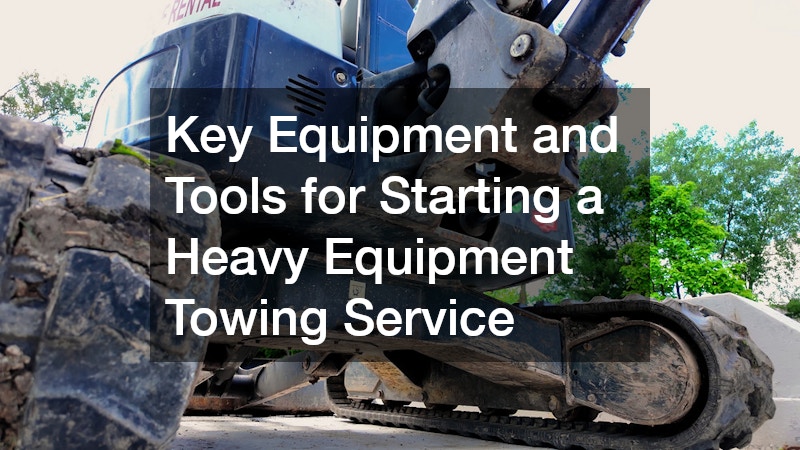The heavy equipment towing industry is a critical part of the logistics and transportation sector, providing necessary services for moving large and often immovable machinery or vehicles. Starting a successful heavy equipment towing service demands a comprehensive understanding of the necessary resources, including a robust fleet of vehicles, specialized tools, and a commitment to safety and reliability as backbone components of a thriving enterprise. Entrepreneurs entering this field must also be prepared to invest in ongoing vehicle maintenance, acquire safety equipment, and develop a knowledgeable team proficient in towing operations.
What are the Essential Vehicles Needed for Heavy Equipment Towing Businesses?
To handle the varied demands of heavy equipment towing, a service needs a range of tow trucks tailored to different functions. Flatbed trucks are essential, providing a versatile solution for transporting damaged or immobile vehicles by lifting them securely onto the truck bed. Integrated tow trucks are crucial for towing larger vehicles like buses and heavy machinery, thanks to their enhanced strength from tow arms and wheel-lift capabilities.
Though less commonly used today due to potential damage, hook and chain tow trucks still serve specific purposes, especially for wrecked vehicles requiring precision and controlled power. With each vehicle serving unique functions, the fleet must be carefully selected to ensure efficiency and versatility. A balanced mix of these vehicles enables a towing operation to handle a wide range of scenarios, from car breakdowns to heavy machinery recoveries.
Flatbeds are vital for safely transporting vehicles without additional damage, while integrated tow trucks combine two-wheel lifts and booms for heavy-duty operations. Hook and chain trucks remain niche, often used for scrap or severely damaged vehicles.
What Tools and Accessories are Necessary for Safe and Efficient Towing?
Safety gear and accessories are crucial in the heavy equipment towing industry, directly impacting the safety and efficiency of operations. Essential items include high-visibility vests, gloves, and helmets, which protect workers and ensure they are easily seen by other road users during towing. Chains, hooks, and straps are vital for securing cargo, minimizing movement, and ensuring stability during transport.
A comprehensive checklist ensures all necessary tools and gear are accounted for, fostering an organized, professional approach that enhances reliability and customer trust. Investing in high-quality towing chains and straps is critical, providing strength and durability for securing heavy loads. Quality tools not only aid in secure operations but can extend the lifespan of accessories and towing vehicles. Winches, essential for pulling vehicles onto the truck bed, must be robust and well-maintained for smooth and safe operations.
Safety gear such as helmets, gloves, and reflective vests protects staff during operations, ensuring safety remains a priority. Chains, hooks, and durable straps secure towed vehicles, while winches and pulleys enhance control and precision during loading and unloading.
How to Maintain and Service Towing Equipment for Longevity?
Regular maintenance and servicing of towing equipment are crucial for sustaining operational efficiency and preventing costly breakdowns. Adhering to a schedule of inspections and tune-ups ensures that all vehicles and equipment operate smoothly, extending their service life and reducing the risk of mid-operation failures. Routine checks help identify potential issues early, enabling timely interventions to prevent minor problems from becoming major ones.
Maintaining detailed service records for all vehicles and equipment tracks maintenance needs and identifies patterns indicating underlying issues. Staff training on proper equipment use and care is also essential for fostering a culture of responsibility toward equipment reliability. A proactive approach to maintenance, supported by a knowledgeable team, is key to ensuring dependable service and prolonging asset life.
Daily pre-operation checks help detect wear and tear early, preventing minor issues from escalating. Scheduled maintenance, including fluid changes, lubrication, and safety inspections, ensures optimal mechanical performance. Implementing a digital logbook system tracks equipment longevity and service intervals, enabling data-driven decisions on upgrades and renewals.
The process of launching and managing a heavy equipment towing business is marked by the necessity of acquiring reliable vehicles, utilizing proper tools, and adopting strict safety and maintenance practices. Ensuring the availability of specialized trucks and equipment, combined with the use of essential accessories and safety gear, is fundamental in guaranteeing successful, efficient, and secure towing operations. Emphasizing robust maintenance procedures and safety practices not only ensures the longevity of your towing equipment but also bolsters the reputation of your service for safety and reliability in the heavy equipment towing industry.
.




